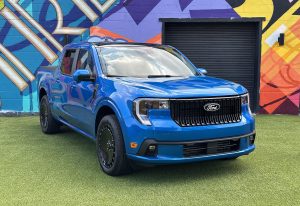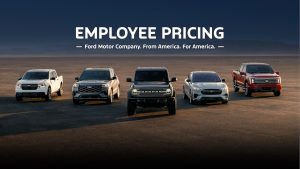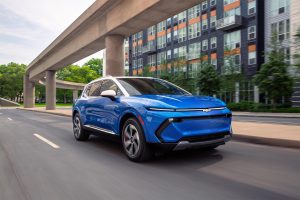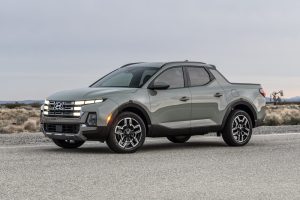Pres. Donald Trump’s tariffs will add billions to the cost of manufacturing vehicles in the U.S., as well as importing products from abroad. So far, however, automakers have been reluctant to pass those higher costs onto consumers, fearing that could trigger a sharp downturn in demand. How long they can continue swallowing those higher costs remains to be seen. More from Headlight.News.

Ford raised prices on the new Maverick by 4%, but most vehicles have gone up less than 1% since tariffs hit.
While there’s really no such thing as a “typical” car buyer, the average new vehicle rolled out of the showroom in June for $48,907, according to Cox Automotive, a 1.2% increase over year-earlier numbers. And while not all automakers have reported in for July, researchers anticipate a roughly similar year-over-year increase.
That might come as a surprise considering the dire warnings many analysts sounded as Pres. Donald Trump launched a wave of new tariffs earlier this year covering such things as imported autos and auto parts, as well as foreign-made steel and aluminum.
Manufacturers have already been hit with billions of dollars in increased costs but so far have declined to translate those into higher prices, experts say, for fear of triggering a sharp slowdown in U.S. sales. But the real question is how much longer they can afford to keep taking those hits to the bottom line. Early signs suggest consumers will start having to cover their share of the tariffs as the industry rolls out its 2026 models.
Automakers take the hit
“On average, tariffs are adding $4,275 (to the cost of producing a new) vehicle, though the effects on individual models vary widely,” said Thomas King, head of data and analytics for J.D. Power. “Despite this, most price increases have remained modest, with some models seeing little to no change.”
While Trump has repeatedly claimed that the country of origin will cover the cost of tariffs, economists note that is inaccurate. Tariffs are added to the cost of goods when they enter the U.S. and, normally, it is the company receiving those goods that must pay the duties – only then deciding whether to pass those costs onto consumers.
Last month, General Motors said it paid $1.1 billion to cover new tariffs, while Ford put its figure at $800 million through the end of June, Ford estimating that will rise to $2 billion for the full year. Stellantis said it has been hit with $300 million in first-half tariffs and forecasts that will rise to $1.7 billion for the full year. Foreign-owned brands, more dependent on imports, are reporting even bigger numbers. Volkswagen puts its figure through the end of June at $1.5 billion. Hyundai For Hyundai, the number came to $600 million with $500 million in tariffs rung up by its Korean sibling Kia.
Consumers make out – for now

Stellantis lost $300 million due to tariffs during H1 2025 and expects a full-year hit of $1.7 billion.
U.S. new vehicle sales hit an all-time record of 17.1 million in 2016 before tumbling to recessionary lows during the first couple years of the COVID pandemic. They fell just short of 16 million in 2024 and originally were forecast to slightly top that mark this year.
As tariffs first went into effect, there was widespread expectation manufacturers would quickly raise prices by $2,000 or more, according to forecasts from the Anderson Economic Group, AlixPartners and others. But with many budget buyers still out of the market, analysts like J.D. Power’s King suggest automakers are reluctant to pass on more than a fraction of their higher costs – for now.
So far, prices are rising “a bit slower than we anticipated as (manufacturers continue) using up inventory they have before turning to inventory that has higher tariffs on it,” Ford CFO Sherry House said during the automaker’s second-quarter earnings call. Looking forward, “We expect that these price increases, of about 1%, will probably hold as we finish out the balance of the year.”
But not everyone is convinced buyers will get such a pass – at least not for that long.
More Auto News
- Auto Sales Up in July But Show Signs of Slowing as Tariffs Take a Bite
- Chevy Teases Return of th Bolt – But Will it Be America’s Most Affordable EV?
- Ford Has a “Model T Moment” Coming Aug. 11, Says CEO Farley
Delayed pain

Stellantis CFO Doug Ostermann expects the company to “make progress” passing tariff costs to consumers in the coming months.
It helps that most automakers who’ve so far weighed in on the second quarter remained solidly in the black – with Stellantis and Tesla being two notable exceptions. Still, the industry can only go so long without spreading out the tariff pain.
Buyers already are seeing fewer special deals on anything but the slowest-selling models. “Instead of discounts rising as they normally would at this time of year, incentive spending has edged down to 6.1% of MSRP in July from 6.3% in January, reflecting the cost pressure that manufacturers are under due to tariffs,” said King.
There have been a handful of products already ringing up big increases, reported the Detroit Free Press. It noted the 2026 version of the Ford Maverick was increased by 5.4%, to $32,104. Ford also raised the price of the all-electric Mustang Mach- 4.2% to $42,229 last month.
In typical times, automakers normally announce any significant price increases at the beginning of the new model year and that could yet happen on a broader scale, Cox Automotive saying it expects to see average transaction prices top $50,000 sometime this year. That would still be a modest 2.2% increase, or less than what tariffs are adding up to for most automakers.
It may take longer than they’d like but “I think we can make progress on pricing,” Stellantis Chief Financial Officer Doug Ostermann said during the company’s earnings call last month. In this case, “progress” is in the eyes of the beholder. For Stellantis, that means reducing the amount of tariff costs it has to swallow as it passes more of that burden onto consumers.







0 Comments